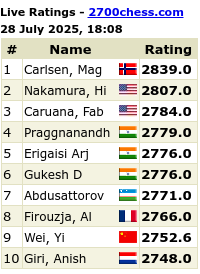This game proves that although it seems like there ought to be loads of tactical chances, on closer inspection after move 14. ..Qc6 it is difficult for White to actually gain any advantage! In fact, I think after move 18. ..dxe5, White potentially had this game lost! The idea in chess (for the unacquainted) is to think 'Checks' 'Captures', 'Threats' in any given position. You must of course put yourself in your opponent's shoes and look for their opportunities as if you were playing for them ... i.e. What would you do if you had the opposing colour? This technique became a habit for me over the years, having played many club games and thrown them away by missing my opponent's threats! Fortunately, in this particular club game, my opponent was not thinking of what I could do tactically and succumbed to playing '* routine moves', hoping to play the game out with a one pawn advantage. The tactic employed after 20. ..Bbd7 is glaringly obvious to those that study tactics ... White gives up the exchange temporarily to gain a piece, namely the Black Bishop.
* routine moves are normally played without really thinking! (but we are all occasionally guilty of this 'chess sin')
Scotch Game
1. e4 e5 2. Nf3 Nc6 3. d4 exd4 4. Nxd4 Nxd4 5. Qxd4 d6 6. Nc3 Nf6 7. Bg5 c5 8. Qd3 Be7 9. Be2 h6 10. Bh4 Be6 11. h3 a6 12. O-O b5 13. f4 Qb6 14. Qf3 Qc6 15. Rad1 Rad8 16. f5 Bc8 17. e5 Qxf3 18. Bxf3 dxe5 19. Bxf6 Bxf6 20. Bc6+ Bd7 21. Rxd7 Rxd7 22. Rd1 O-O 23. Rxd7 Bg5 24. Ne4 Be3+ 25. Kf1 c4 26. Nd6 Bg5 27. Bd5 Bf6 28. Bxf7+ Kh7 29. Bg6 Kg8 30. Ne8 e4 31. Nxf6+ Rxf6 32. Rd8+ Rf8 33. Rxf8+ Kxf8 34. Ke2 Ke7 35. Ke3 Kd6 36. Kxe4 a5 37. Kd4 Kc6 38. g4 a4 39. a3 Kb6 40. h4 Ka5 41. g5 hxg5 42. hxg5 b4 43. Kxc4 bxa3 44. bxa3 Kb6 45. f6 gxf6 46. gxf6 1 0
PGN Viewer courtesy of http://chesstempo.com/












